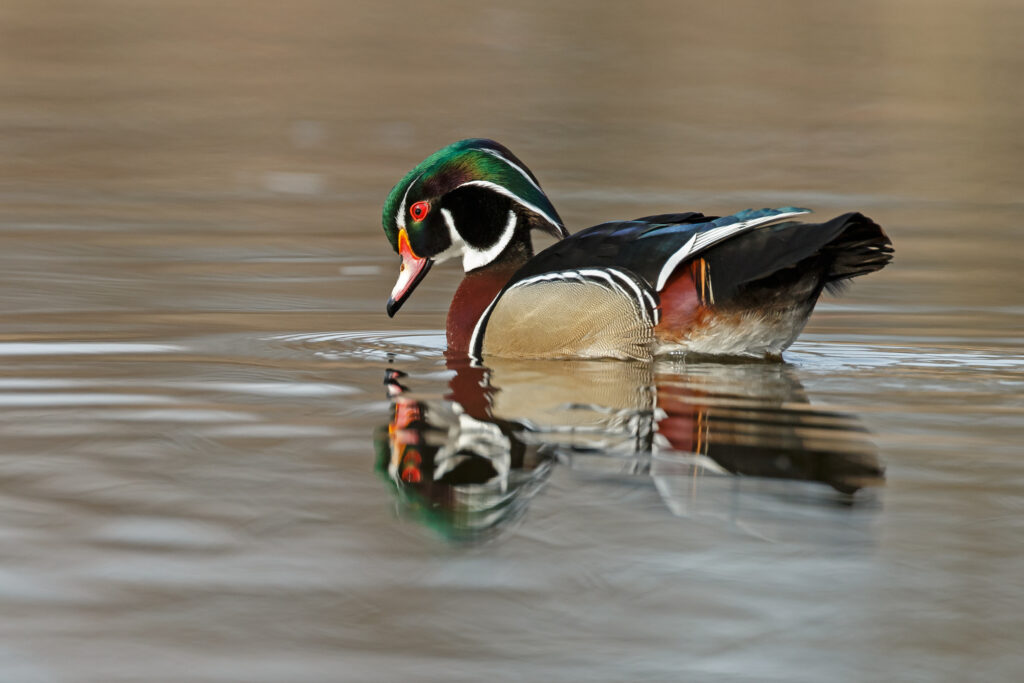North Dakota is home to beautiful mountains, stunning coastlines, and vibrant cities. In all of these habitats, you will find interesting wildlife and birds.
North Dakota is home to beavers, bears, cougars, elk, white-tailed deer, and so many more species. It’s also an ideal state for birders, as there are more than 420 wild bird species in the state.
Of those species of birds, there are dozens of kinds of ducks in North Dakota.
Ducks are a fun challenge for many birders. While some ducks are plentiful and fill local fields, shallow ponds, and streams, there are many species that are only rarely spotted in the state. Ducks can be social or reclusive, aggressive or shy.
Let’s take a look at 24 different kinds of ducks you will find in North Dakota, whether in the winter, the summer, year-round, or during their migration.
But first, we should define some important terms!
Defining Terms: Dabbling Ducks, Diving Ducks, and More
Ducks can be categorized into two main categories: dabbling ducks and diving ducks.
When diving ducks collect food, they submerge themselves entirely under the water, sometimes diving as far as 200 feet underwater, like the Long-Tailed Duck.
Dabbling ducks, on the other hand, only tuck their head underwater. Sometimes, they will flip upside down so that their head is under the water and their tails stick out above the surface.
Some ducks also dive but aren’t necessarily called diving ducks. These are categorized as “sea ducks.” Their behavior is the same as a diving duck, so they are sometimes labeled as such, but they also have their own family: Merginae.
We will identify each duck in our list as a dabbler, diver, or sea duck.
Take note: North Dakota is also home to other waterfowl, including geese, coots, swans, and more. We are focusing on ducks, mergansers, and scoters in this list.
Identifying Ducks by Sight, Sound, and Behavior
Ducks, like other birds, can be identified based on several observable characteristics. In our list, you will find information about the size, appearance, behaviors, and range of each duck.
You can use the following to identify ducks:
- Appearance (coloring and patterns)
- Size (length, weight, and wingspan are typical measurements)
- Habitat (this often changes between summer and winter)
- Range (there are consistent patterns and then occasional deviations from those patterns)
- Behavior (how they eat, breed, raise their young, etc)
- Sounds & Vocalizations (including mating calls, communicative sounds, and alarms for other ducks)
- Silhouette (shape)
If you are new to looking for ducks, this information is important: adult males often change their appearance from the breeding season to the winter season. Females may do the same, but this is a very common trait of male ducks.
One of the reasons this happens is that males want to attract a mate in the summer, but they need to camouflage themselves well in the winter.
Females are less likely to change their appearance as they don’t need to attract a mate through a showy performance of color. They are safer year-round because of their more muted patterns and colors.
As they tend to stay with their ducklings while they are helpless and defenseless, female ducks do better when they can camouflage year-round.
Now that we have covered the basics, it’s time to get started on our list of 25 ducks in North Dakota!
American Black Duck (Dabbling Duck)
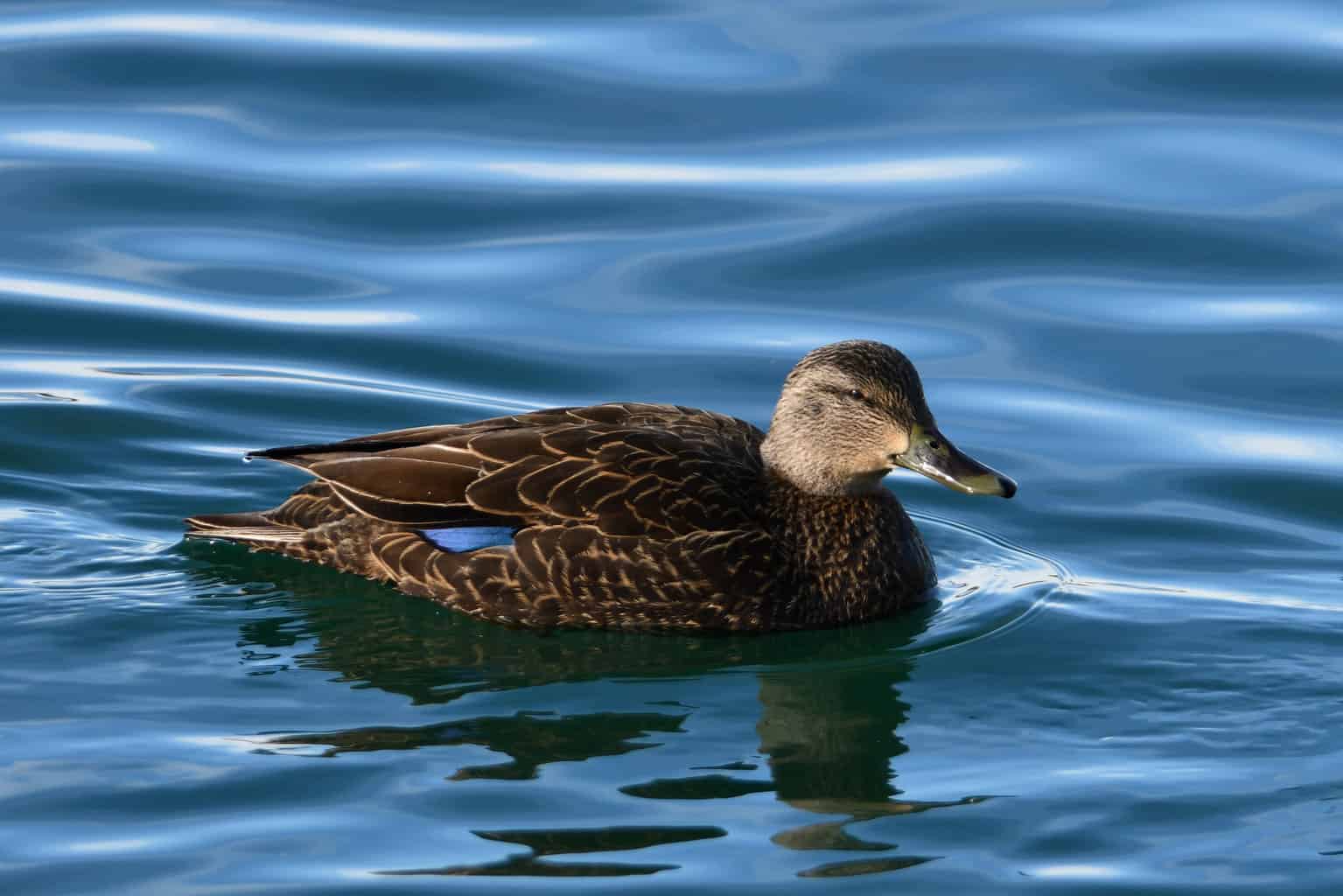
- Anas rubripes
- Length: 21.3-23.2 inches
- Weight: 25.4-57.9 ounces
- Wingspan: 34.6-37.4 inches
The male American Black Duck is dark brown with a violet-blue speculum that is most visible when he is in flight. His patterning looks like a very dark version of a female Mallard. His bill is yellow.
Females are very similar to their male counterparts. The female is just slightly lighter brown, and her bill is green.
American Black Ducks live almost exclusively in the North American east. They are year-round residents of New England, breeding residents in Canada, and winter residents in the south.
Black Ducks prefer wooded habitats, but deforestation has led to declining populations.
American Black Ducks live in just the northeast corner of North Dakota, in the Red River Valley and the northern edge of the Drift Prairie. Have patience if you want to see them — they are shy!
They have been documented in several National Wildlife Refuges, including Agassiz, Rydell, Hamden, and Long Lake, just over the border in Minnesota.
American Wigeon (Dabbling Duck)

- Mareca americana
- Length: Up to 14 inches
- Weight: About 2.25 pounds
- Wingspan: 34 inches
The distinctive feature of a male American Wigeon is his thick white crown and an iridescent green band that stretches from his eyes to the back of his head. He has a black-tipped bill that is otherwise blue-gray, as well as black tips on his wings. Most of his body is brown, but he has a black tail.
Female American Wigeons are light brown. They have gray, dappled heads and dark eyes. Her bill is also blue with a black tip.
The American Wigeon breeds in western Canada and Alaska. Their winter territory is very wide, including the Pacific Coast, Atlantic Coast, Gulf Coast, parts of Texas, and the western states of North America. They also migrate to Mexico, parts of Central America, and the far northern regions of South America.
Their breeding range includes most of North Dakota. One great place to see them is Long Lake National Wildlife Refuge in Moffit.
Black Scoter (Sea Duck)
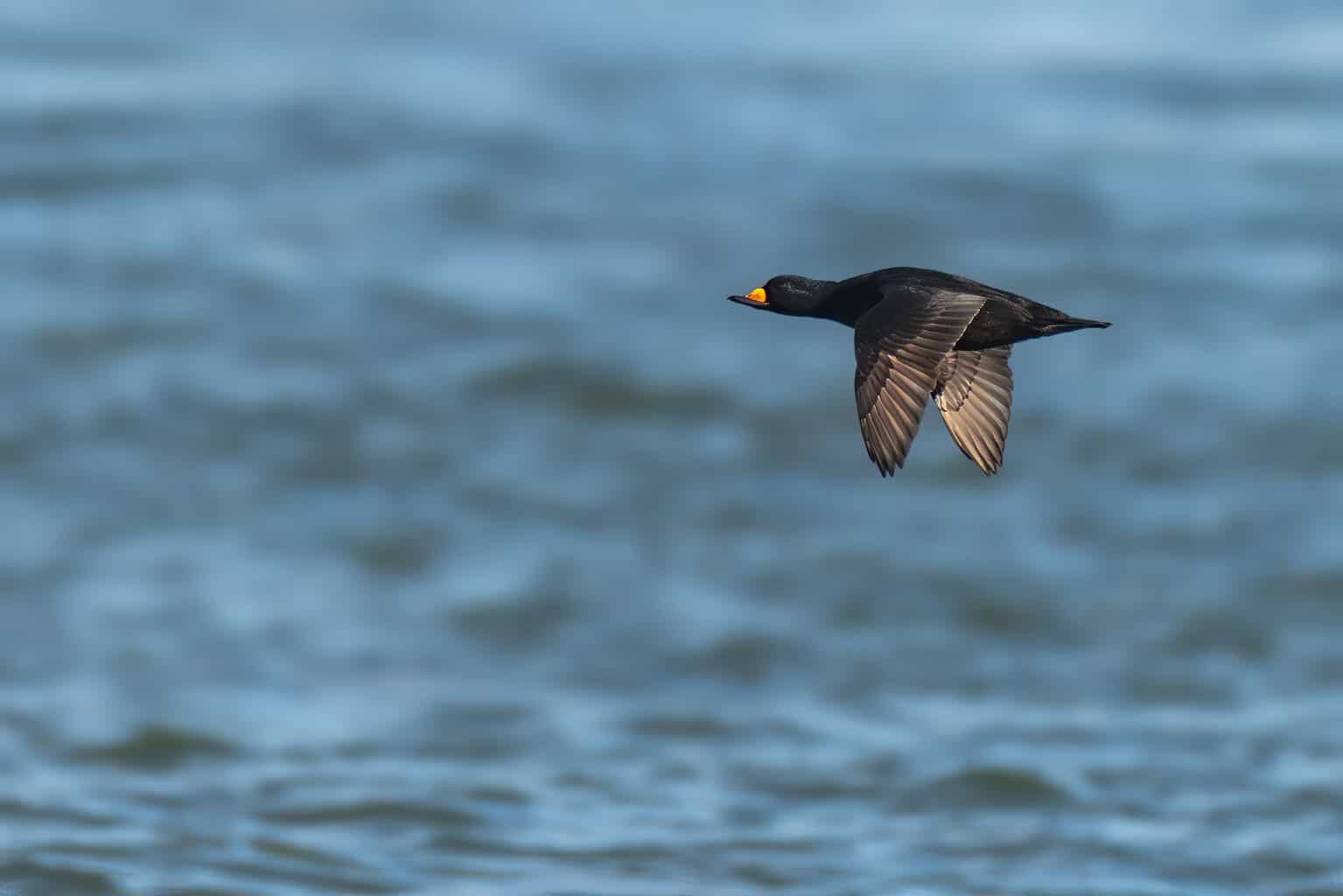
- Melanitta Americana
- Length: 127 – 21 in (43 – 53 cm)
- Weight: 387.4 oz (1088 g)
- Wingspan: 30 – 35 in (76 – 89 cm)
Male Black Scoters are known for the bulbous orange bulge at the base of the bill. The rest of his bill and body are all black, including his legs.
Females have a thick black bill, but they lack a bulging base. The female’s body is a blending of light and dark brown and has a mottled appearance. She has a pale gray cheek and a thick, dark brown strip atop her head.
Black Scoters have a pretty small breeding range. They breed either in northern Alaska or in Quebec. Their winter territory includes the coastal waters of the Atlantic, Pacific, and Gulf of Mexico.
In North Dakota, Black Scoters are a rare, accidental species that may be spotted between October and November as they migrate between their summer and winter territories.
Blue-Winged Teal Duck (Dabbling Duck)
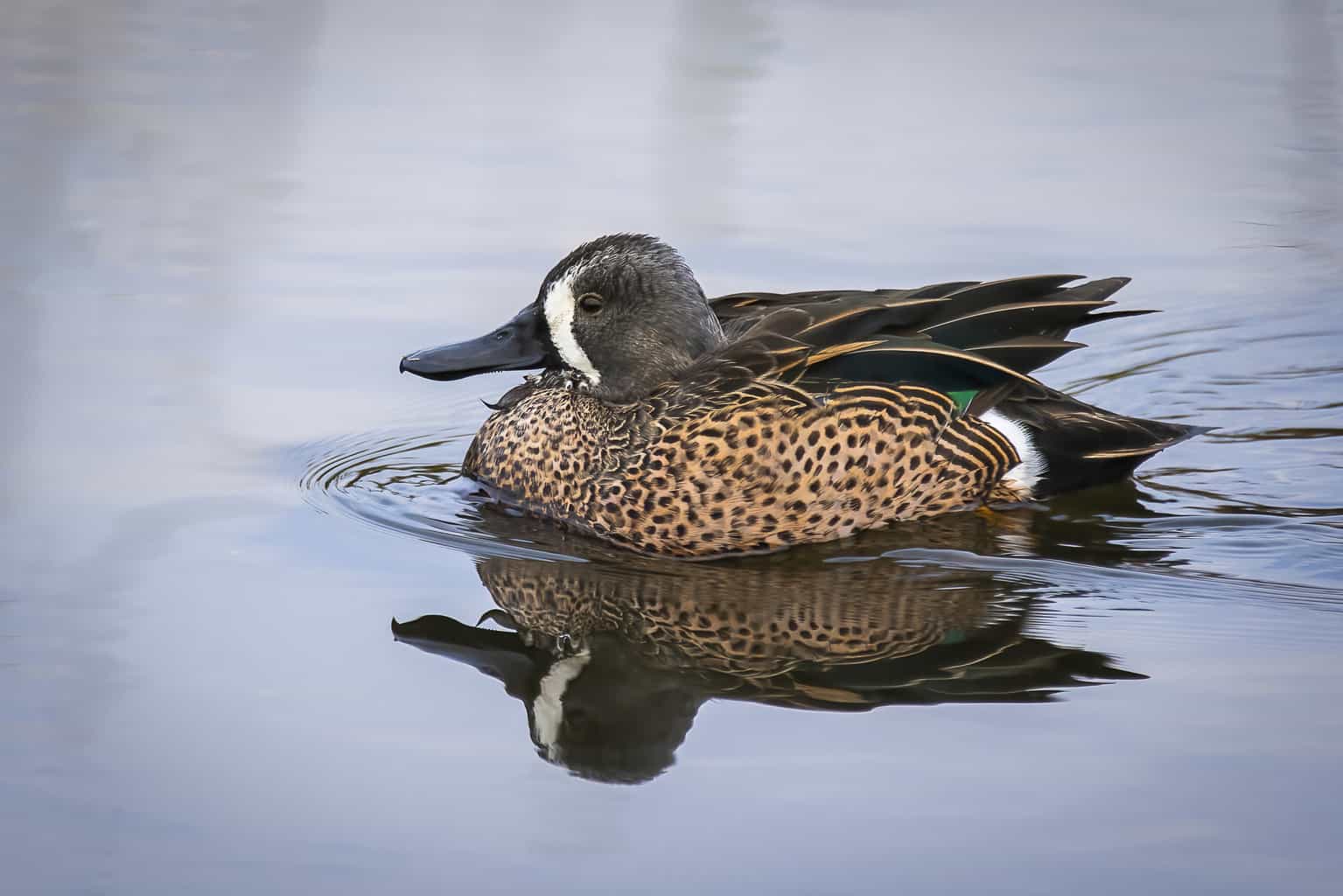
- Spatula discors
- Length: 15 – 17 in (38 – 43 cm)
- Weight: 19.18 oz (544 g)
- Wingspan: 23 -31 in (58 – 79 cm)
The male Blue-Winged Teal Duck is identifiable because of the large white crescent shape in front of their eyes. The rest of their head is blue-gray, and their body is a mottled brown. They have a black back, blue shoulder patch, and green speculum on their secondary feathers.
Females don’t have that easy-to-spot facial crescent. They are mottled brown and look like female Mallards, but they are much smaller.
Blue-Winged Teal Ducks are tough little ducks, but they also have high mortality rates, possibly because of how far they migrate. Blue-Winged Teals also may also be responsible for spreading avian influenza to commercial poultry farms.
The Blue-Winged Teal is a summer resident of North Dakota. They nest throughout the state and are the most populous duck in the state. They arrive in late spring and are among the first ducks to leave in the fall.
Bufflehead (Diving Duck)

- Bucephala albeola
- Length: 13 – 16 in (33 – 41 cm)
- Weight: 21.16 oz (600 g)
- Wingspan: 21.6 in (55 cm)
Male and female Buffleheads have rounded heads that look a bit like puffballs. The male’s head is dramatic and attention-grabbing in sections of iridescent green and purple that are divided by a large fan-shaped white patch. His body is black and white.
Females have a dark brown body, a pale gray breast, and a fluffy, dark brown head.
North Dakota sees Buffleheads travel through the state during their migration windows, but some also nest in the state in the Turtle Mountains. They are almost exclusively found in woodlands and forests in the state.
For the most part, Buffleheads live in cavities, especially the abandoned tree cavities of Northern Flickers. However, they are also more likely than some other duck species to adopt a nest box.
If you live near a coastal bay, pond, stream, or swamp, you may be able to attract Buffleheads to your property with a purchased or homemade nest box.
Canvasback (Diving Duck)
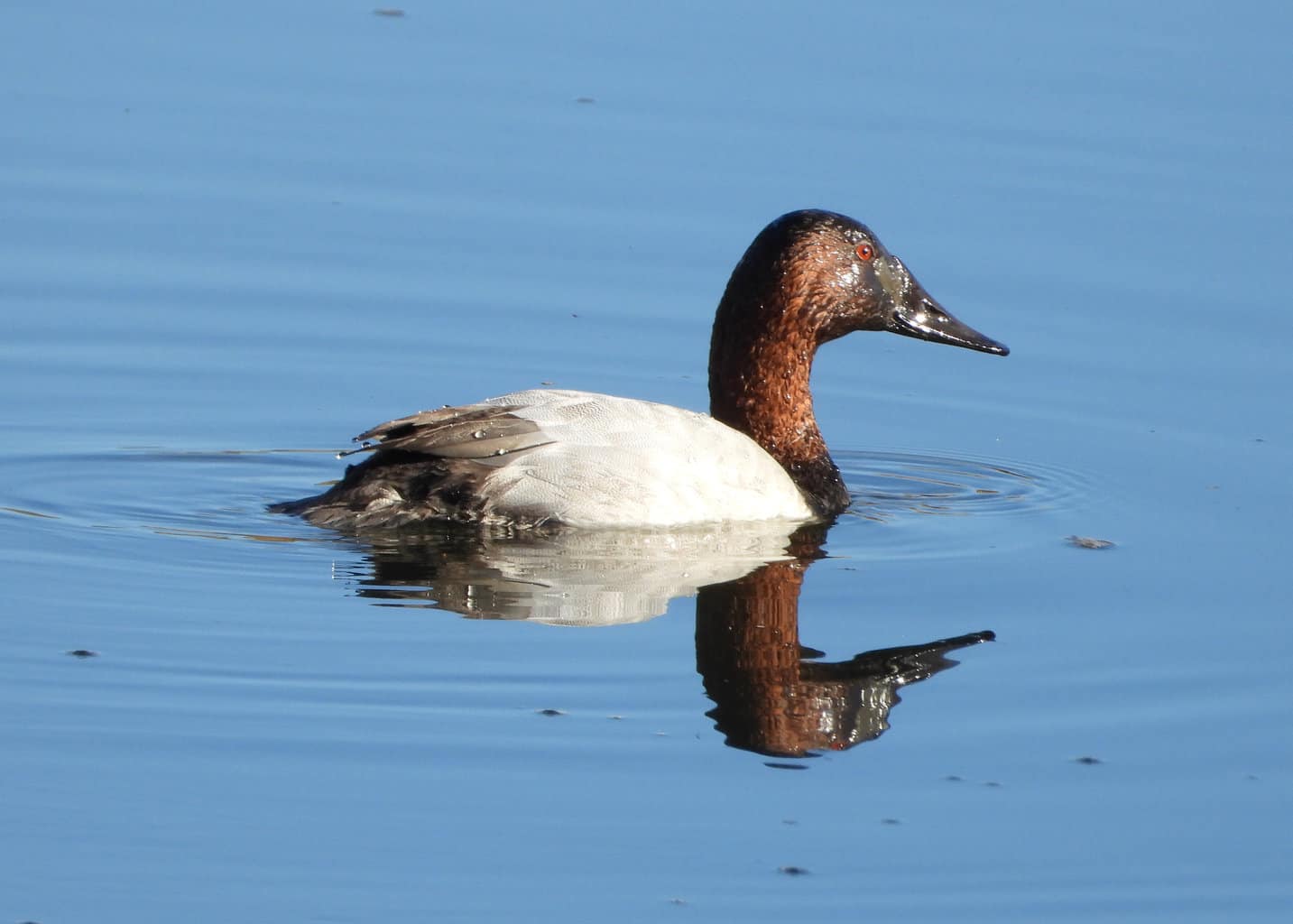
- Aythya valisineria
- Length: 19 – 24 in (48 – 61 cm)
- Weight: 58.48 oz (1657 g)
- Wingspan: 28 – 36 in (71 – 91 cm)
As North America’s largest diving ducks, Canvasbacks demand a lot of attention!
The male Canvasback has a sloping head that is dark, reddish-brown, and a gray canvas-colored body. His bill is thick, broad, and black. His back and his tail feathers are black, but his eyes are red.
The female, on the other hand, is like a muted version of the male, but her eyes are black instead of red.
Interestingly, males and females migrate to different territories in the winter. Researchers think that this might have to do with the fact that males are stronger and more capable of withstanding bad weather. It’s also possible that females migrate away from males in order to avoid competition for their favorite food and resources.
North Dakota’s Canvasbacks arrive in the middle of March for the breeding season. They leave by November. You are most likely to see ducklings between May and August.
Cinnamon Teal Duck (Dabbling Duck)

- Spatula cyanoptera
- Length: 11 inches
- Weight: 12.6-18.2 ounces
- Wingspan: 25 inches
Male Cinnamon Teal Ducks, during the breeding season, have a rusty brown head and neck. Their shoulders are the same, but their primary feathers are brown and black. Their secondary feathers are green.
At the end of the breeding season, males molt and lose their dark colors. They end up looking more like the female during the winter, which makes it a bit more difficult to differentiate between the sexes.
Females and non-breeding males are dark and light brown with coarse mottling. Her bill is thick and black.
Cinnamon Teal Ducks are primarily located on the western side of North America. The first Cinnamon Teal Ducks in North Dakota were identified in 1978, but duck hunters often recount their rare encounters with Cinnamon Teals, suggesting that they are occasionally in the state.
Cinnamon Teal Ducks are exceptional at camouflage, so it is possible that some individuals are in the state but go undetected.
Common Goldeneye (Sea Duck)

- Bucephala clangula
- Length: 16-20 inches
- Weight: Approximately 1.8 pounds
- Wingspan: 30.3-32.7 inches
The Common Goldeneye male is black and white with a metallic green head and white patches on his wings. He has a bright yellow eye that is visible even from a distance.
The female is brown, and her bill is tipped with yellow. Her head is a much darker brown than the rest of her body. Her eyes are also golden-yellow.
Common Goldeneyes are aggressive ducks who fight one another with some frequency. Sometimes, when two females fight, their hatchlings scatter and end up joining a new “family.” This is not something you will observe in North Dakota, though, because they do not breed in the state.
These ducks are pretty rare in North Dakota, and there are few accounts – if any – of Common Goldeneyes nesting in the state. However, there are usually at least some of them here in the winter. They may be found on the Missouri River, below the Garrison Dam.
Common Merganser (Sea Duck)

- Mergus merganser
- Length: 22 – 27 in (56 – 69 cm)
- Weight: 60.8 oz (1723 g)
- Wingspan: 31 – 37 in (79 – 94 cm)
Common Mergansers are striking in their appearance. The male has an iridescent green head, a bright red bill, black eyes, and a black back. His belly is white.
The female has a shaggy reddish-brown crest. She has a white breast, but her belly and back are gray.
They use their serrated, strong bills to catch and rip apart the fish that make up their diet. They can also crack into mollusks and eat worms, insects, frogs, and even small mammals. All mergansers have this same serrated bill, and their diets are very similar to one another.
Common Mergansers are migratory throughout most of North Dakota, but they may spend the winter in the southwestern corner of the Missouri Plateau. They are typically associated with the North American coastlines, but they also inhabit large lakes and rivers.
They may be spotted alongside Buffleheads.
Gadwall (Dabbling Duck)
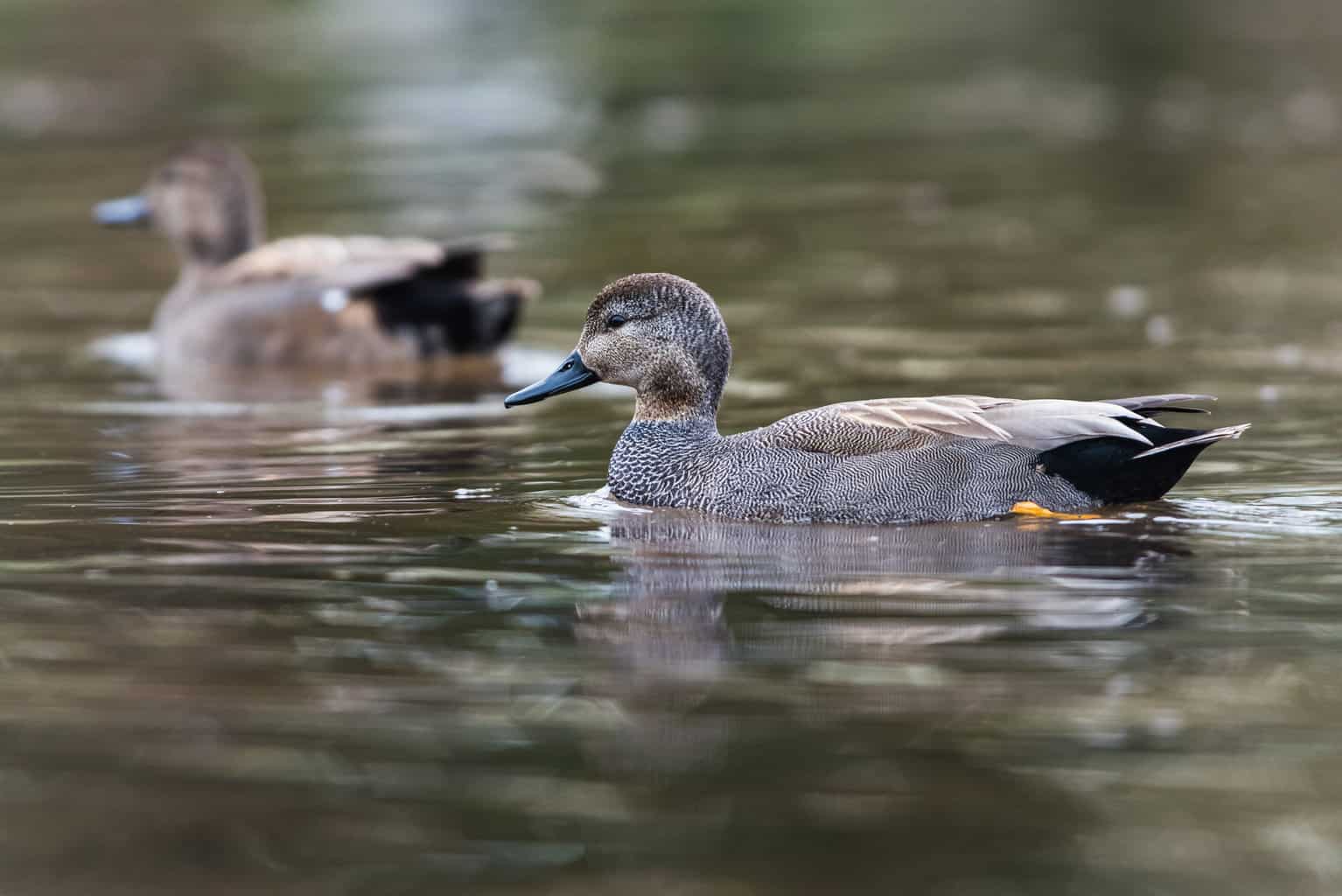
- Mareca strepera
- Length: 19 – 23 in (48 – 58 cm)
- Weight: 35.27 oz (1000 g)
- Wingspan: 31 – 36 in (79 – 91 cm)
The male Gadwall is delicately patterned. He has tiny black scallops on his grayish chest. His tail feathers are black, and he has a brownish-gray dappled head.
Females are patchy with dark and light brown coloring. The female’s bill is orange, which contrasts with the black bill of the male.
Gadwall males and females have white marks on their wings.
Gadwalls are very plentiful in North America, in part because they are very successful at breeding. They are very popular with duck hunters, too.
North Dakota is more densely populated with Gadwall than any other state! They are prevalent throughout the state’s wetlands, as they feed on the aquatic grasses that are abundant in our rivers: sago pondweed, hardstem bulrush, and salt grass.
Greater Scaup (Diving Duck)
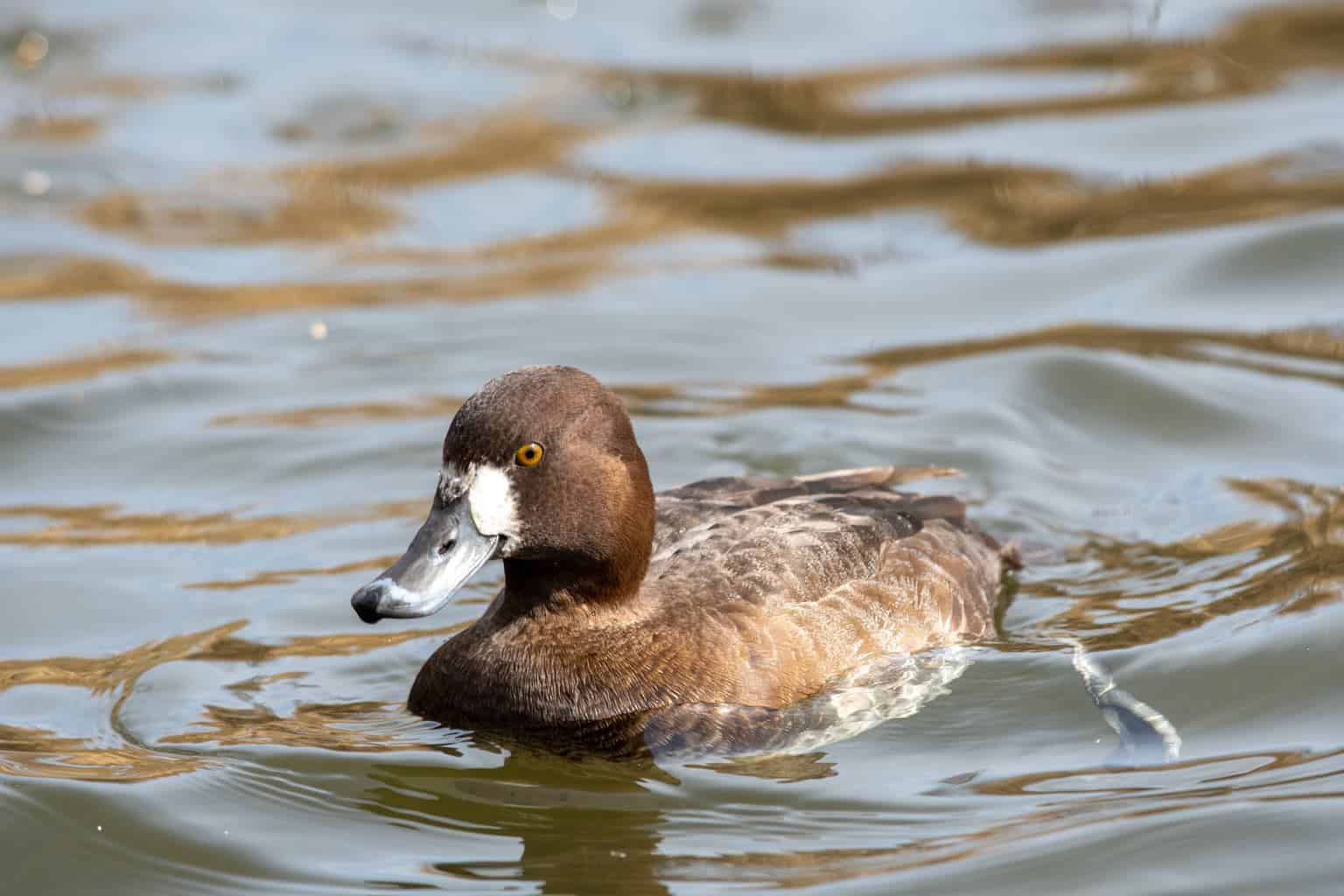
- Aythya marila
- Length: 15-22 inches
- Weight: 1.5-2.9 pounds
- Wingspan: 28-33 inches
Bother Greater Scaup and Lesser Scaup are found in North Dakota. Male Greater Scaup are mostly white with black and brown bars across their back. During the breeding season, they have an iridescent green head.
Females and non-breeding males are light brown in body and have dark brown heads. They don’t have much in the way of markings, but the female does have a thick pale ring on her face, circling the base of her bill.
Whether or not you will see Greater Scaup in North Dakota is dependent upon where you are in the state. In the east, they are migratory ducks who are only stopping by on their way to and from their longer-term habitats. In the west, however, they are winter residents.
Green-Winged Teal Duck (Dabbling Duck)
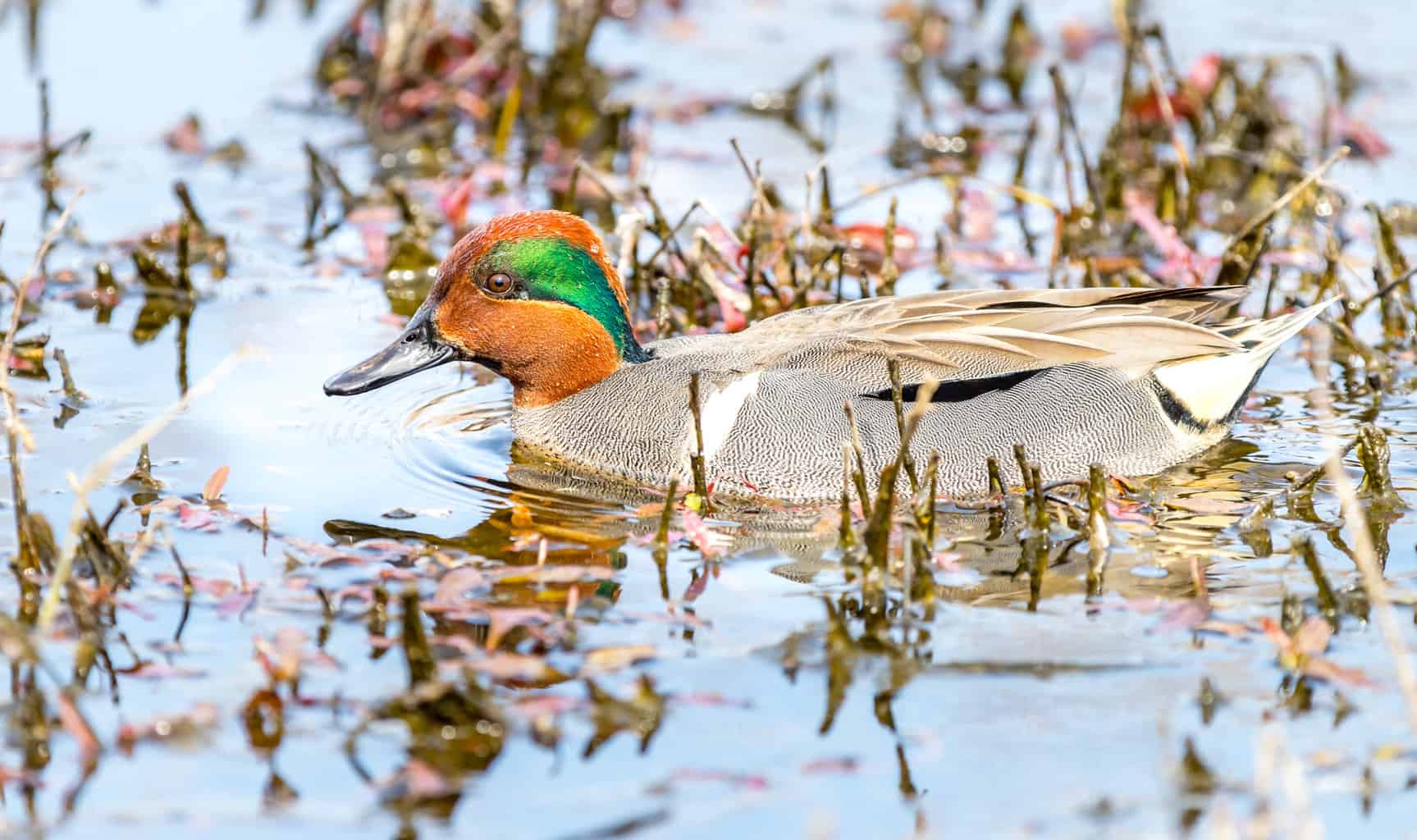
- Anas crecca
- Length: 12.2 – 15.3 in (31 – 39 cm)
- Weight: 4.9 – 17.6 oz (140 – 500 g)
- Wingspan: 20.5 – 23.2 in (52 – 59 cm)
The male Green-Winged Teal Duck has a metallic green stripe that runs from his eyes to the base of his neck. Otherwise, his head is chocolate-brown. He has a mostly gray body.
Females vary from light to dark brown, but she has a distinctive yellow streak along the length of her tail. Both males and females have a green speculum, which gives them their name.
Green-Winged Teal Ducks can take off from a body of water without needing a running start. This gives them an excellent defense mechanism against threats.
They are mostly migratory in North Dakota, but there are at least some that nest in the state. When they build their nests, they choose dense grasslands near protected waters.
Hooded Merganser (Diving Duck)
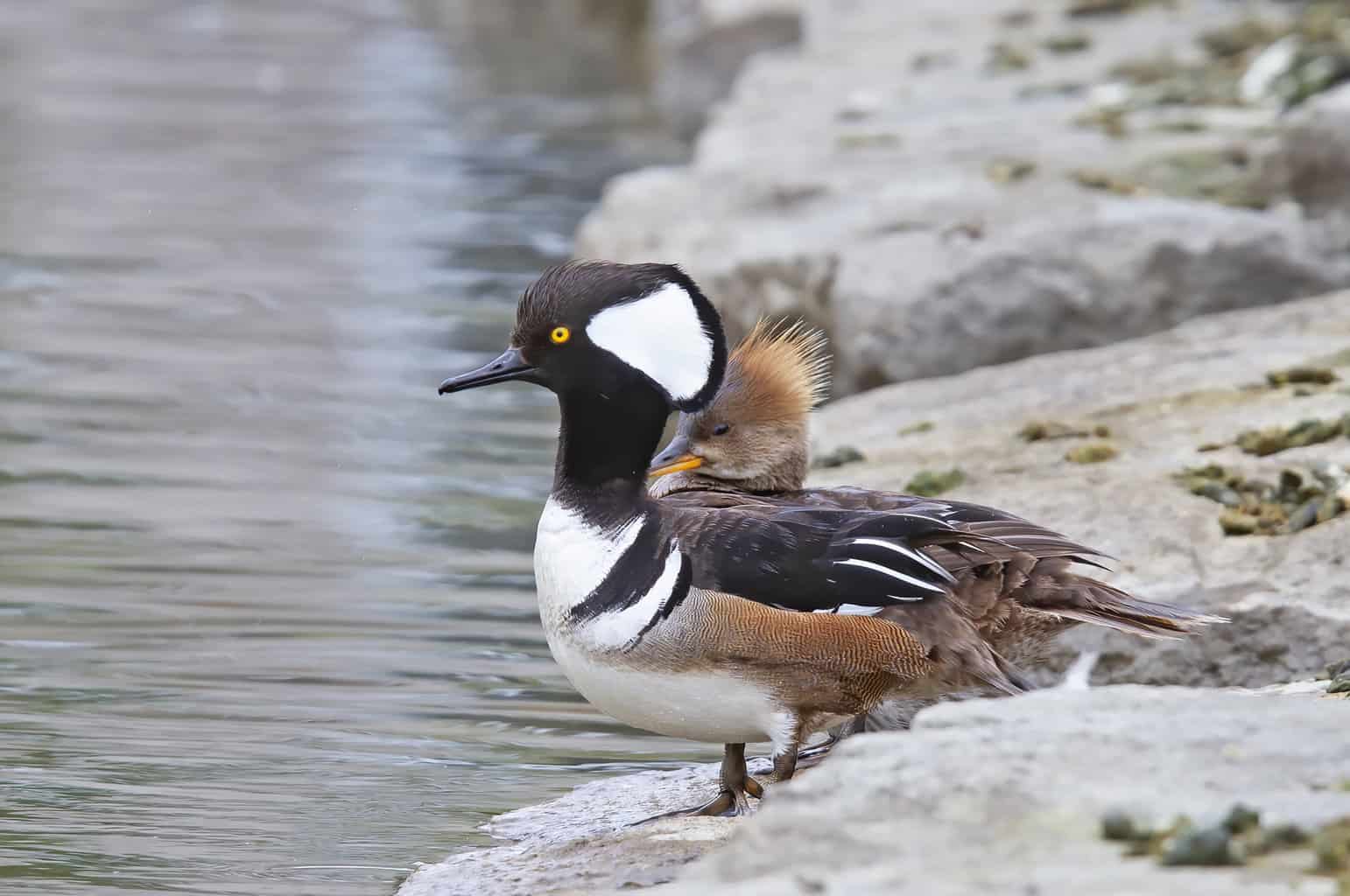
- Lophodytes cucullatus
- Length: 16 – 19 in (41 – 48 cm)
- Weight: 32.09 oz (909 g)
- Wingspan: 24 – 26 in (61 – 66 cm)
Hooded Mergansers have a fluffy head, thanks to their large crest. The male’s crest is black and white, and he can raise it and lower it at will. His body is black and white, and he has brown sides.
Females have a shaggier crest, which is cinnamon-brown. She lacks other distinctive markings on her body, which is brown, but females have some orange coloring on their long bills.
Like the Common Merganser species and the Red-Breasted Merganser, the Hooded Merganser’s bill is serrated, which is perfect for tearing apart prey.
The Hooded Merganser’s nickname is “frog-duck” because their vocalizations sound like the croak of a pickerel frog.
Hooded Mergansers are breeding-season-only ducks in North Dakota. They stick to the eastern half of the state, in and near the Red River Valley. They nest in sheltered woodlands.
Lesser Scaup (Diving Duck)

- Aythya affinis
- Length: 15 – 18 in (38 – 49 cm)
- Weight: 40.77 oz (1155 g)
- Wingspan: 24 – 33 in (61 – 84 cm)
Lesser Scaup look a lot like their close relatives, the Greater Scaup. Males have a dark greenish-purple iridescent head that looks almost black from a distance. His body is barred in gray and white.
Females are dark brown. Like the Lesser Scaup, Greater Scaup females also have a white patch on their face, near their bill.
The easiest way to differentiate between these two species is to look at the very top of their heads. Lesser Scaup have a few stray “hairs” atop their heads, creating just the tiniest little crest.
They are quite good at both camouflage and another useful defense mechanism: playing dead.
In North Dakota, Lesser Scaup are common breeding residents. That said, their population has been on the decline since the 1980s, and researchers are struggling to figure out why that is the case.
They arrive in the middle of March and leave again in November, but their peak breeding season lasts from May to August.
Long-Tailed Duck (Sea Duck)

- Clangula hyemalis
- Length: 15 – 22 in (38 – 56 cm)
- Weight: 31.74 oz (900 g)
- Wingspan: 26 – 31 in (66 – 79 cm)
Many ducks change their appearance from the breeding season to the winter. Long-Tailed Ducks are one of the only ducks that completely reverse their coloring. Both males and females switch their color patterns between seasons.
In winter, male Long-Tailed Ducks are white on the shoulders, crown, neck, belly, back, and forehead. His cheek patches, breast, tail feathers, and wings are black. He also has a gray eye mask.
When summer arrives, all of the black parts of his body turn white, and all of the white parts turn black.
Females do the same, but they are brown and white. Their winter appearance features a white head and brown body, but their breeding season look is a brown head and white body.
Long-Tailed Ducks are uncommon in North Dakota. Their breeding range is almost exclusively located in the Arctic Coast of Canada and Greenland, and their winter territory includes the Pacific Coast and Atlantic Coast of Canada. They also spend the winter in New England.
In North Dakota, they are rare, accidental migrants who have moved outside of their typical migration patterns.
Mallard Duck (Dabbling Duck)

- Anas platyrhynchos
- Length: 19.7 – 25.6 in (50 – 65 cm)
- Weight: 35.3 – 45.9 oz (1000 – 1300 g)
- Wingspan: 32.3 – 37.4 in (82 – 95 cm)
The Mallard is iconic because of the male’s stunning coloring and patterns. He has an iridescent green head and a gray body. There is a white ring around his neck, and he has a brown breast, a baby blue speculum, and a bright yellow bill.
Females are streaked and speckled in shades of brown. The female’s head is light brown, and her bill is multi-colored. It is mostly orange, with a black patch on the top and a black tip.
You’ll find Mallards represented in paintings, home decor, collector’s items, figurines, and even kids’ toys.
- Love, play, cuddle and squeeze! Squishmallows are the softest, cutest plush toys around!
- Meet Avery the Mallard Duck! Featuring soft plush fabric, Squishmallows have their own style and personality encouraging fun and...
- The snuggle is real! The large squishy plush makes for the perfect cuddle companion! These super soft, collectible plush toys are...
Last update on 2024-04-27 / Affiliate links / Images from Amazon Product Advertising API
They are the world’s most common ducks. Naturally, they are commonplace in North Dakota, too. The fact that they are not North Dakota’s most plentiful duck is noteworthy because they are the most populous ducks in most states.
There are abundant within the state. Basically, anywhere that the Mallard can find food and water is hospitable enough to call home!
Mallards are incredibly adaptable ducks who can adjust their diet, habitat needs, and nesting preferences to match what is available. Perhaps this is why they are so successful at breeding and surviving, even in harsh climates!
You can find Mallards in North Dakota during their migration periods and in the summer. Some will stick around for the winter, too.
Northern Pintail (Dabbling Duck)

- Anas acuta
- Length: 20 – 26 in (51 – 66 cm)
- Weight: 36.33 oz (1030 g)
- Wingspan: 29 – 35 in (74 – 89 cm)
The male Northern Pintail has several long, pointed feathers during the summer. They fall off when he molts into his winter appearance, but his tail is still pretty pointed. His body is mostly gray, with brown, white, and black markings. His head is dark brown, and a white stripe runs down his neck.
The female has a short and pointy tail. Her body is intricately patterned in light and dark brown scales.
These are fast flyers, clocked at up to 48 miles an hour.
Northern Pintails are breeding-season ducks in North Dakota. They arrive in March and depart in November. Most of their breeding occurs between April and May.
They prefer to nest in prairies and wetlands, including agricultural waters, pastures, and fields. Their North Dakota diet includes seeds, grasses, and invertebrates.
Northern Shoveler (Dabbling Duck)

- Spatula clypeata
- Length: 17.3 – 20.1 in (44 – 51 cm)
- Weight: 14.1 – 28.9 oz (400 – 820 g)
- Wingspan: 27.2 – 33.1 in (69 – 84 cm)
Northern Shovelers‘ iridescent green heads are reminiscent of the Mallard’s head. He has a thick, black, spatula-shaped bill that he uses to scoop up water and mouthfuls of prey. His body is mostly gray, and his wings and sides are brown.
Females have an orangish-brown bill and orange legs. Her head is dark brown, and the rest of her body is coarsely patterned in light and dark brown.
When threatened, female Northern Shovelers defecate on their eggs to deter predators from wanting to eat them.
North Dakota doesn’t see Northern Shovelers in the winter, as they move south for the non-breeding season. However, it is relatively easy to spot them in their breeding season or during their yearly migration windows.
Watch for their unique feeding habits. A few dozen birds will gather together in the water and begin to rotate at the same time, much like a group of pinwheels. This stirs up the water and gives them access to food that comes up from the bottom of the river or pond.
Red-Breasted Merganser (Sea Duck)

- Mergus serrator
- Length: 16 – 26 in (41 – 66 cm)
- Weight: 47.61 oz (1349 g)
- Wingspan: 31 – 35 in (79 – 89 cm)
The male Red-Breasted Merganser has a shaggy crest on his dark green head. he has a thick, white ring around his neck and an orange sawbill. His body is marked in gray, brown, black, and white.
The female’s crest and head are cinnamon-brown. Her body is mostly grayish-brown, but her throat is white.
Their sharp, serrated bills are used to rip into their prey, which consists of small fish, crustaceans, tadpoles, and aquatic insects.
Red-Breasted Mergansers are incredibly fast, too. They can fly up to 81 miles per hour.
They are migratory throughout most of the United States, including North Dakota. You won’t find them nesting here or settling down for the winter, but in the spring, small groups or pairs will stop on their way north. Their fall migration may include thousands of birds traveling together!
Redhead Duck (Diving Duck)
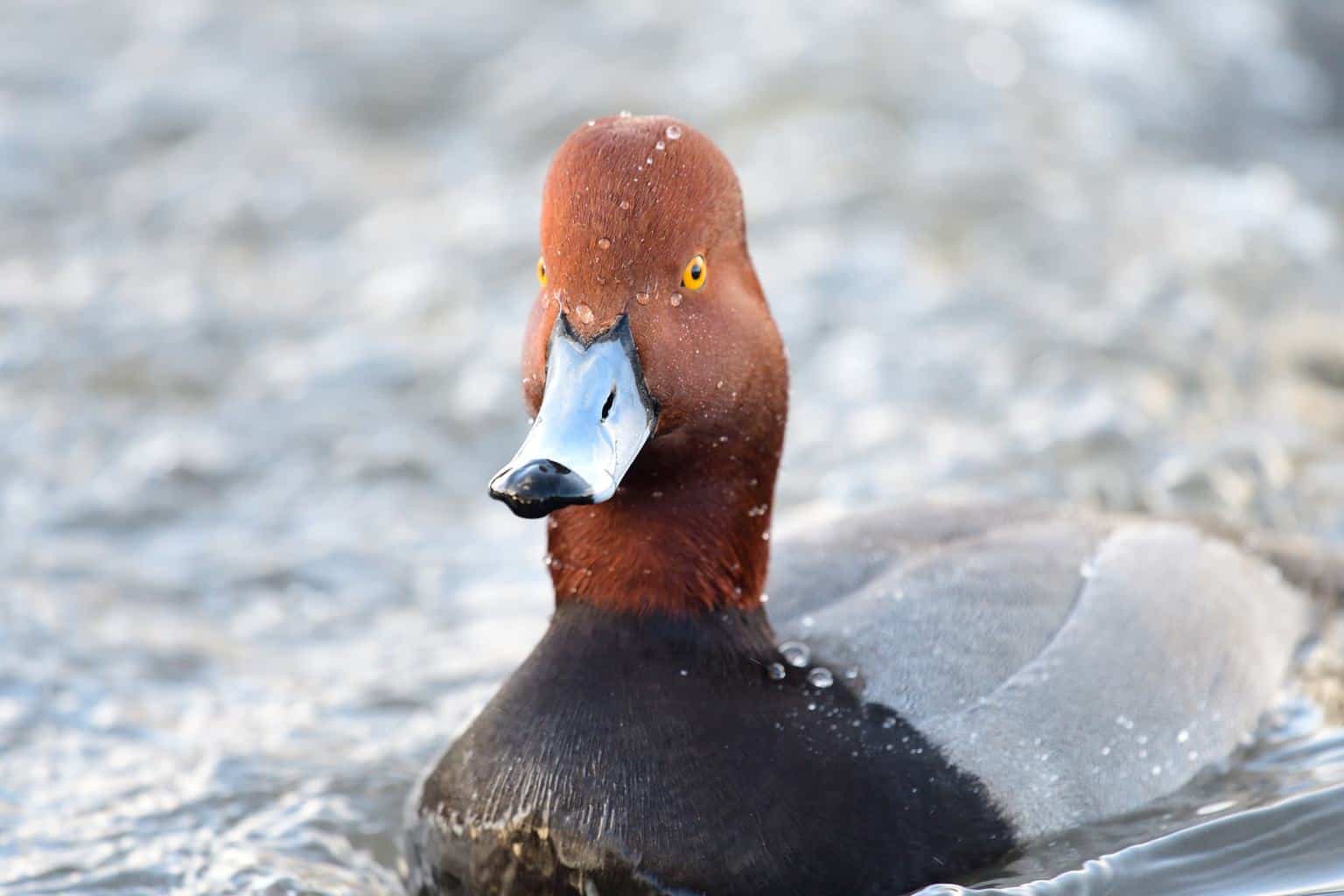
- Aythya americana
- Length: 18 -22 in (46 – 56 cm)
- Weight: 43.03 oz (1219 g)
- Wingspan: 29 – 35 in (74 – 89 cm)
The male Redhead has a dark, coppery-brown head and a dark gray bill with a black tip. His body boasts a stark contrast between his black chest and his gray sides and back.
Female Redheads are all brown, with very few discernable markings. Their strong bills are tipped in black, like the male.
Redhead Ducks are occasional brood parasites, which means that they sometimes lay a few eggs in other ducks’ nests. This helps to improve their overall reproductive success.
Redheads are incredibly common in the state during their migration and during the breeding season. They leave for the winter and travel to the United States South and Southeast, the East Coast, and parts of the Midwest. They are also abundant in Mexico during the winter.
Watch for Redheads in North Dakota’s prairies and valleys.
Ring-Necked Duck (Diving Duck)

- Aythya collaris
- Length: 14 – 18 in (36 – 46 cm)
- Weight: 32.09 oz (909 g)
- Wingspan: 24 – 30 in (61 – 76 cm)
Despite their name, the copper ring on the neck of a Ring-Necked Duck is barely visible. You have to be incredibly close to the duck to see it. However, there is a ring around the male’s bill that stands out, and he also has a thin white outline around the base of his bill.
The rest of the male’s body is mostly black, including his chest, back, and head. His sides are gray.
The female Ring-Necked Duck is brown, and she lacks the white outline around the base of her bill. She does, however, have a white band near the end of her bill.
Ring-Necked Ducks are uncommon migrants and breeding-season residents, and they do not live in North Dakota in the winter. Their diet is made up of aquatic insects, seeds, and grasses.
They prefer shallow water and avoid large, deep lakes and rivers. When they are spotted in the state, they are often together with Greater and Lesser Scaup.
Ruddy Duck (Diving Duck)
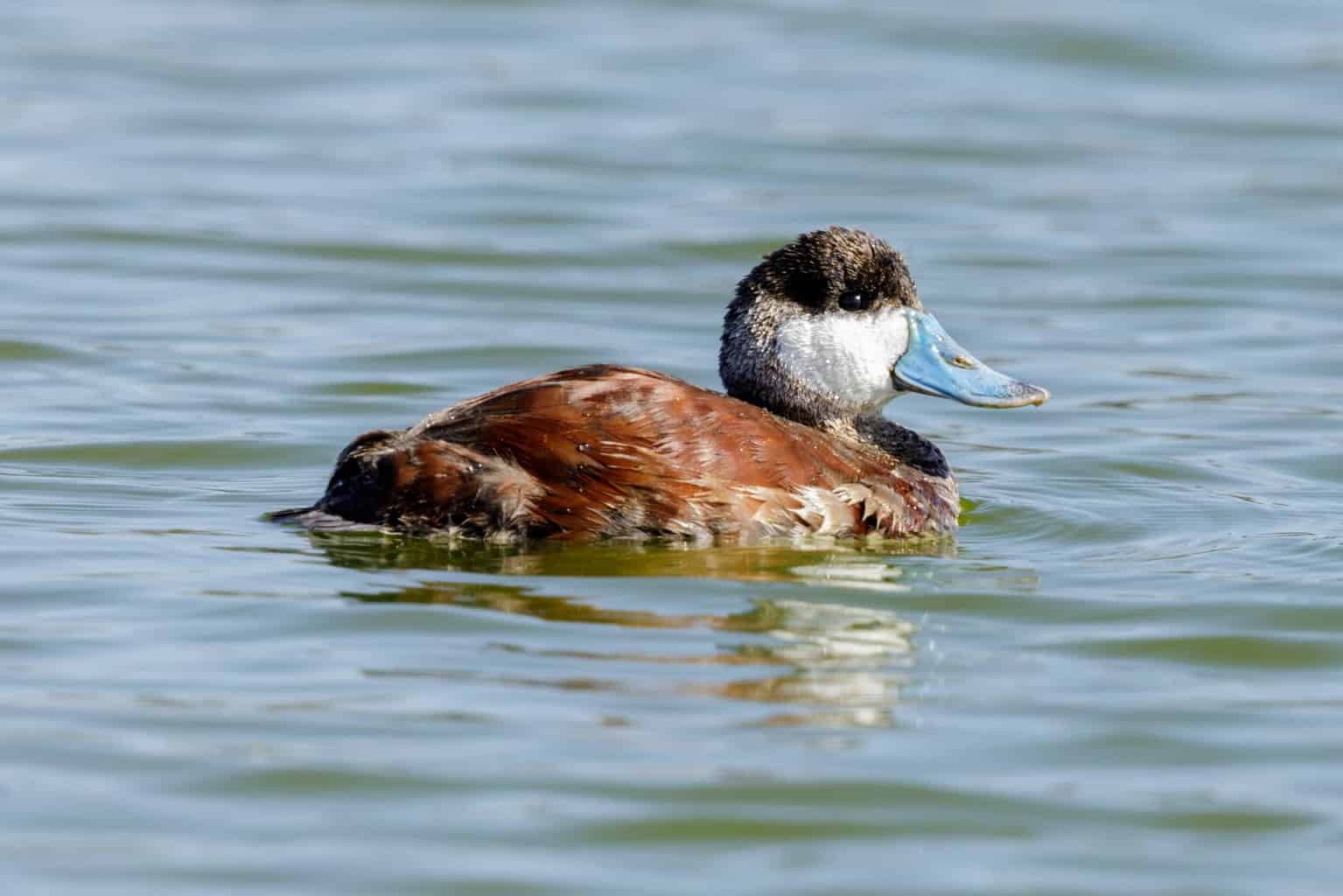
- Oxyura jamaicensis
- Length: 14 – 16 in (35.56 – 40.64 cm)
- Weight: 28.04 oz (795 g)
- Wingspan: 21 – 24 in (53 – 61 cm)
During the breeding season, from May to August, male Ruddy Ducks have dark brown feathers over most of their body, with a black head, large white cheek patch, and broad, light blue bill. They molt for the winter into a dullish gray.
Females have dappled brown feathers and a gray cheek patch. The female has a black bill. Unlike more reclusive ducks, Ruddy Ducks tend to be tamer and less afraid of people.
Sometimes, they are called the “bull-necked teal,” as they are bulky in their appearance and have thick, strong necks.
Although Ruddy Ducks are native to North America, they were brought to the UK in the 30s and 40s. Captive individuals escaped in the 1950s and began to thrive across parts of Europe.
Today, these ducks are considered invasive, and much of Europe is trying to eradicate them because of the way they threatened White-Headed Ducks through interbreeding.
In North Dakota, Ruddy Ducks are commonly identified in the breeding and migration seasons. They are found in freshwater marshes and ponds. Watch for them throughout the state.
Their nests are usually hidden among the dense aquatic vegetation that is close to their chosen ponds and wetlands. The female weaves trasses and cattails just a few inches away from the water.
White-Whinged Scoter (Sea Duck)

- Melanitta deglandi
- Length: 19 – 24 in (48 – 61 cm)
- Weight: 62.4 oz (1768 g)
- Wingspan: 33 – 41 in (84 – 104 cm)
Like other scoters, White-Winged Scoters also have a thick bill. Males and females are very similar in appearance. They are both dark, although the male is a bit darker than the female. He also has a “reverse comma” marking over his eyes and a long white stripe on his wings. She has a very small patch of white on her cheeks.
North Dakota is just barely outside of the White-Winged Scoter’s typical breeding range. That’s why you may occasionally find a nesting pair in the state, especially along the northern border between North Dakota and Canada.
While not usually included in the White-Winged Scoter’s migratory path, North Dakota may occasionally see them as they move from their northern breeding grounds to their coastal winter habitats.
Birders have been documenting White-Winged Scoters in the state for decades. Although they are still considered to be quite rare, there have been enough confirmed sightings that they belong on this list.
Wood Duck (Dabbling Duck)
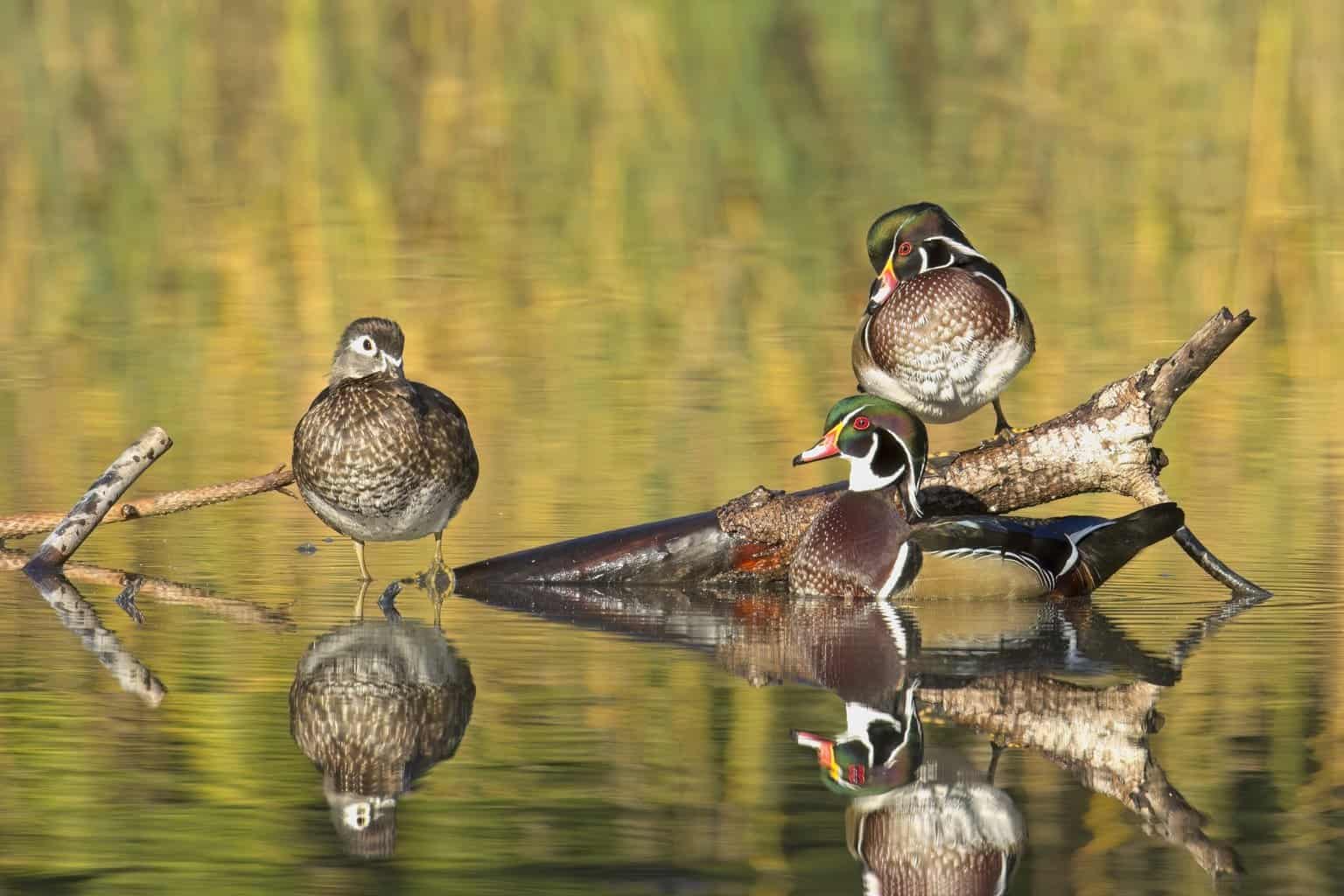
- Aix sponsa
- Length: 18.5 – 21.3 in (47 – 54 cm)
- Weight: 16.0 – 30.4 oz (454 – 862 g)
- Wingspan: 26.0 – 28.7 in (66 – 73 cm)
Male Wood Ducks are vibrantly colored. Their sides are buff-brown, and their breast is chestnut brown with dappled creamy spots. He has an iridescent green head with a long, downward-angled crest.
His bill includes black, white, orange, and yellow areas. He also has dramatic white stripes all over his body.
Females are gray-headed and brown-bodied. The female Wood Duck also has a small crest, and her eyes are outlined in white.
You are likely to find Wood Ducks in North Dakota in the summer, when they nest along the state’s major rivers, including the Missouri, Yellowstone, James, and Red Rivers. They also inhabit ponds and marshes.
They prefer to stay in wooded areas, where there is plenty of shelter from predators and other threats.
Spotting Ducks in North Dakota
Spotting ducks in North Dakota is a wonderful pastime.
There are so many incredible birds in this state, including songbirds, birds of prey, woodpeckers, hummingbirds, and more. You can check out our North Dakota Bird Guide for more information about some of the most interesting species in the state!
Every year, 22 million tourists come to North Dakota. Many are here to enjoy the state’s natural wonders, including wildlife and bird life.
Learning to identify ducks can be a fun and rewarding activity. You don’t have to be a duck hunter or an experienced birder to develop the fun hobby of finding and documenting ducks.
We recommend taking some supplies with you when you are out looking for ducks:
- Good shoes
- Rain gear
- A notebook and pencil
- A birdwatching and identifying app (like Merlin from the Cornell Lab of Ornithology)
- A great pair of binoculars or compact binoculars
If you are getting serious about finding unique ducks in the wild, you might want to try out a spotting scope, too!
The best time of year to find ducks in North Dakota is during the summer. Many species leave for the winter, and only a handful are here year-round.
If you are traveling to North Dakota to visit in the summertime – or if you are lucky enough to live in the state year-round – challenge yourself to see how many of these interesting ducks you can find on your own!

